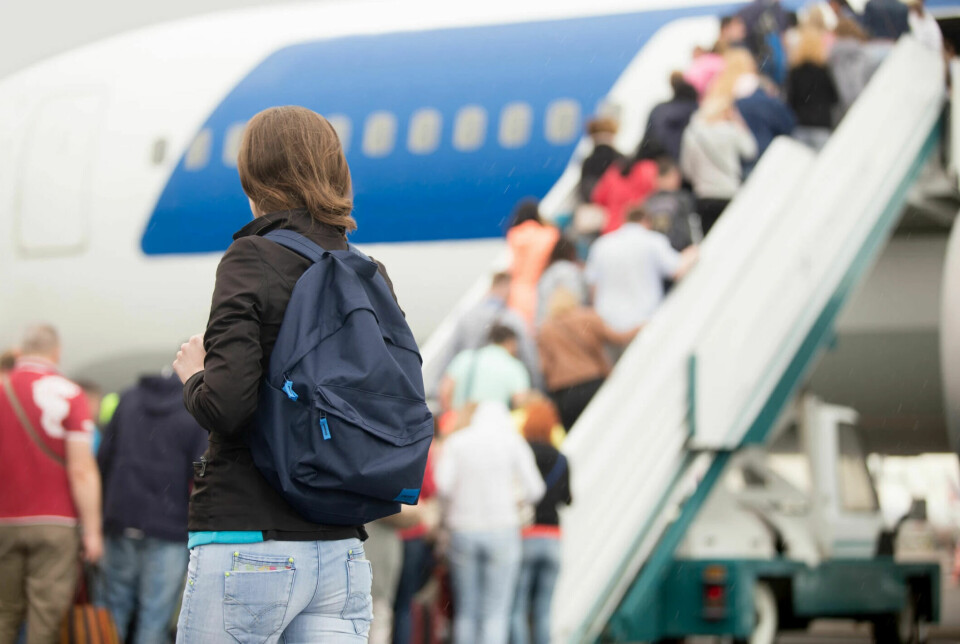
Here's how you can make air travel a little better for the climate
Is it not an option to cut out air travel this year? Then there are a few things you can do to reduce emissions, according to a researcher.
The number of trips abroad is back at the same level as before the pandemic, according to new figures from Statistics Norway (link in Norwegian).
Do we really have to travel so much?
That was one of the questions asked at the Centre for International Climate and Environmental Research's (CICERO) seminar on air travel recently.
Can we travel less or shorter? How can we travel differently? And is flying still an option?
One of the most polluting things we do
In Norway – and in the world – air transport accounts for approximately two per cent of our emissions. It may not sound like much, but the researchers illustrate it in this way:
If aviation were a country, it would be the sixth-largest emitter.
In addition, there is another important part of the picture: Air travel constitutes a significant portion of each individual's carbon footprint.
It is therefore one of the most polluting things we do. And Norwegians are among the worst:
They contribute more than twice as much greenhouse gas emissions through air traffic than the global average.
Three ways to reduce emissions from flying
Borgar Aamaas is a researcher at CICERO with a background in meteorology and climate. He has compiled a short list of possible ways to reduce emissions from flying:
- Avoid traveling
- Change the mode of transportation
- Change/reduce the emissions method
Let's start with point three. How is the development of emission-free aircraft going?
The Civil Aviation Authority (CAA) of Norway’s goal is for all domestic civil aviation to be electrified by 2040. This would result in a reduction of greenhouse gas emissions by at least 80 per cent compared to 2020, according to a report from the CAA and airport operating company Avinor (link in Norwegian).
But what shall we do in the meantime?

Full flights
“When you do fly, take a fully packed flight,” Aamaas says.
That way, you can be sure that you contribute as little emissions as possible when you do fly.
But this can be difficult to know in advance. And the airline can choose to set up another flight if one becomes full.
“When you fly business class, there are usually fewer people on board because each seat gets more space. So it would be best to fly economy class,” Aamaas says.
In fact, your flight can contribute to about 300 per cent higher emissions if you fly in first class compared to economy class, according to Aamaas.
He provides three tips:
- Fly as direct as possible. It reduces emissions during takeoff and landing.
- Choose an airline that has a modern fleet and operations.
- Opt for shorter flights. Distance is the most important factor, and the shorter the flight, the lower the emissions overall.
Change the way you travel
Alternative means of transportation are the second item on Aamaas’ list. Can we choose something other than flying?
“For the trip between Oslo and New York, there are no real alternatives. But for Oslo to Bergen and Trondheim, trains are a good option,” he says. “This also applies to train travel in the Nordic countries and perhaps further down the continent as well. Both trains and buses fare better than flying.”
But if we travel by diesel train from Trondheim to Bodø – a 10-hour journey – the differences are smaller, Aamaas points out.
Not all trains in Norway or Europe run on electricity. Approximately 60 per cent of the Norwegian railway lines are currently electrified, while the Nordland Line, Røros Line, and Rauma Line still use diesel trains, according to the Great Norwegian Encyclopedia (link in Norwegian).
What about cars? Is it better to drive now that we have electric cars? Statistics show that in 2022, for the first time, electric cars drove more than petrol-powered cars in Norway.
“If you are alone in the car, it usually makes more sense to fly rather than drive a petrol car. But if you have a full car with five passengers, it is environmentally more beneficial to drive,” Aamaas says. “And, of course, an electric car is a better option than flying, almost regardless.”
Skip the trip
Now, onto the researcher’s final point – avoid taking the trip altogether.
The pandemic has shown that it is actually possible to significantly reduce air travel, Aamaas says.
“Digital tools can make many trips unnecessary. Leisure travel is less of a necessity, perhaps with the exception of visits to family and close friends scattered around the world,” he says.
Another option is to travel less frequently but stay longer at each destination.
“It’s possible to change the destinations and still have a fantastic experience,” Aamaas says.
———
Translated by Alette Bjordal Gjellesvik.
Read the Norwegian version of this article on forskning.no





































